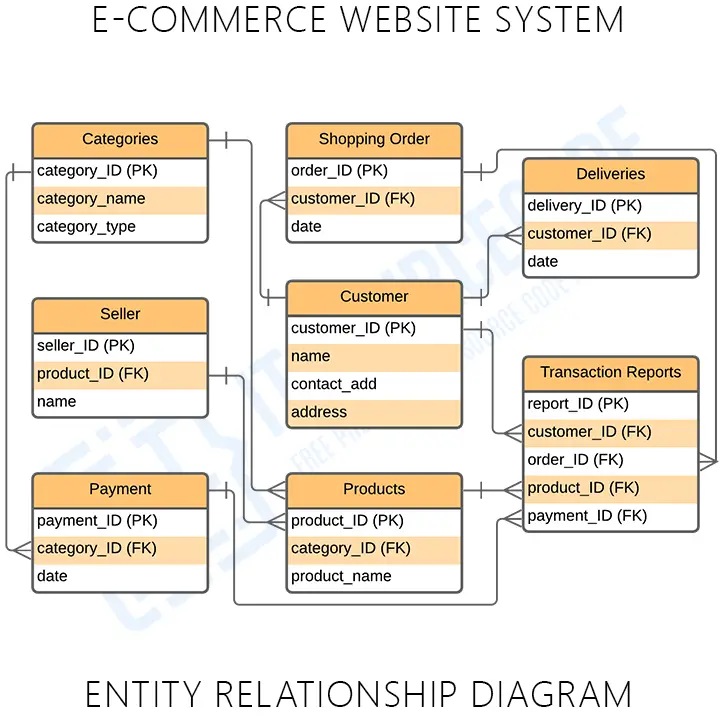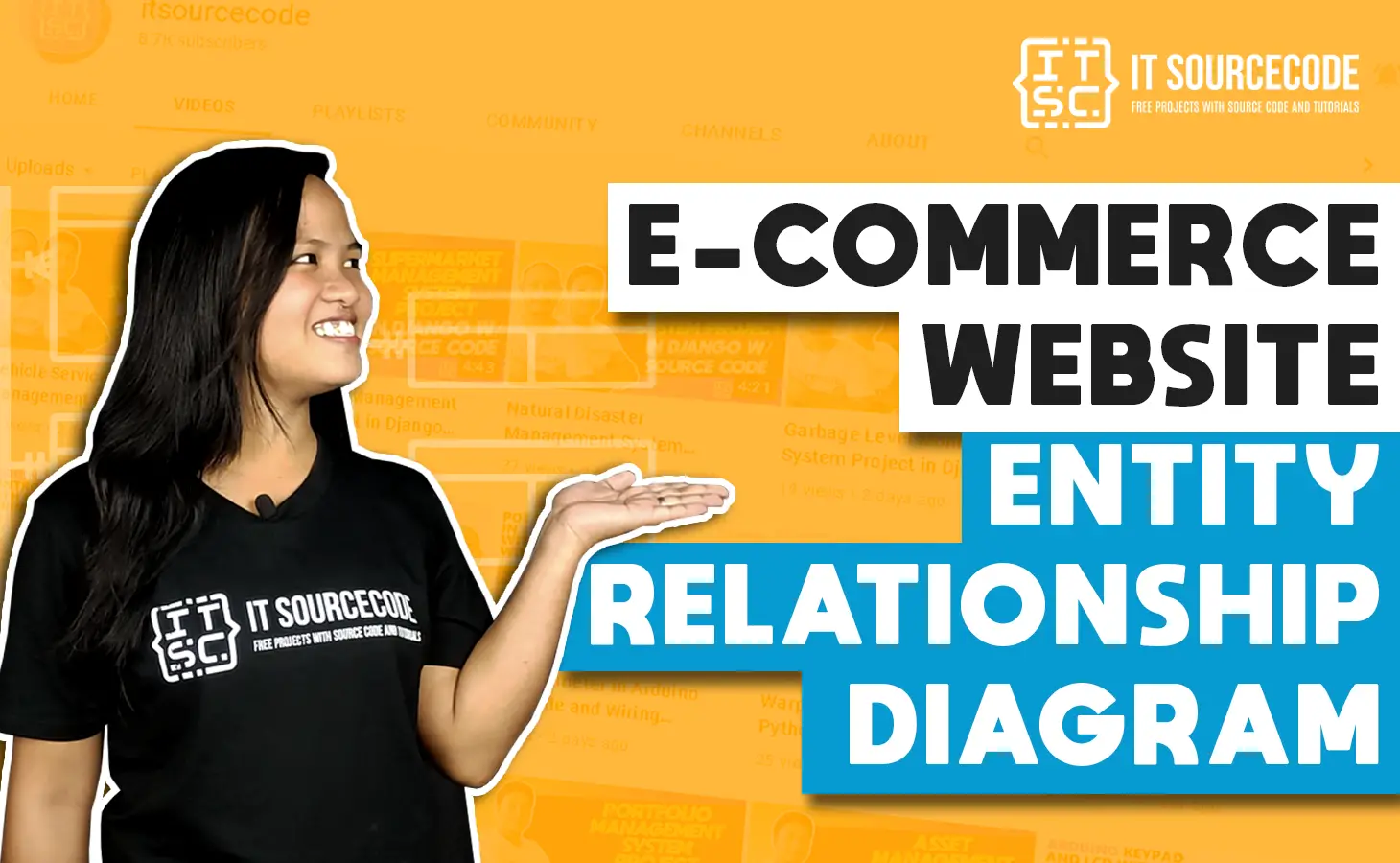The E-commerce Website ER Diagram site shows how it uses database design to handle data used for e-commerce management tasks (ERD). It shows how the database links the different parts of the website. This shows how databases are put together logically by naming entities, their properties, and how they interact with each other.
The ER Diagram for the E-commerce site’s database is drawn out. The ER Diagram is used to plan and fix the relational database of the system. It works best with DFD (Data Flow Diagram), which is in charge of moving data.
Simple ER diagram for e commerce website
The table shows the name and details of the ER Diagram for an E-commerce Website. It has a complete description of the project’s information.
| Name: | E-commerce Website ER Diagram |
| Abstract: | This ER Diagram for an E-Commerce website shows entities, their attributes, and the connections between them. This ER Diagram is a picture of how all System entities are related to each other. |
| Diagram: | ER Diagram (Entity Relationship Diagram) |
| Users: | Buyers (Customer), Seller, and Website Admin |
| Tools Used: | Diagraming tools that provide ER diagram symbols. |
| Designer: | ITSourceCode.com |
What is E-commerce Website?
An e-commerce website is a website that allows people to buy and sell physical things, services, and digital products without having to go to a store. An e-commerce website allows a company to take orders, accept payments, manage shipping and logistics, and provide customer service.
It enables you to obtain a more in-depth understanding of your customers. This includes details such as their gender and age, as well as how they found your website and learned about you. You can track their actions on your website, such as what they looked at and how they came to buy from you.
Features of E-commerce ERD
- E-Commerce Websites: The process of an e-commerce website is the main feature of this system, wherein its database contains the basic details of every transaction made by the customers.
- Customer Management: This feature plays a big role in the system because it gathers important information about the customers. This data was used to keep track of their transactions and other important system details.
- The selling admin can manage the customer’s and products’ information as well as the status of their orders and details of their transactions.
- This system handles customer transactions, which include orders and reservations. This will also serve as the basis for the admin to track the transactions that are made in the system.
- Transaction and Reports Management: This feature will store the transactions made by the customers, including their information and their timetables.
Importance of ER diagram of e commerce website
The importance of the ER Diagram for an e-commerce website is that it helps in modeling its data storage or database. It is the basis of the project’s database foundation for construction. This entity-relationship diagram (ERD) also helps define the types of data to be stored, such as their attributes and properties.
In addition to that, the ER Diagram also describes how an entity interacts with other entities. All other real-world projects are presented with ER Diagrams (database designs).
Simple ER diagram for E-commerce Website
This simple ER diagram for an e-commerce website shows the supposed database design of the project. It conveys the data that would be present in an e-commerce website, its characteristics, and its connection with other data (entity).
The basic e-commerce system The Website ER diagram can also be considered as the database diagram for a website. This is what the database of the system is built on. It keeps track of the data and where the outputs come from.

Based on the image above, the Entity-Relationship diagram for an e-commerce website is the database design presented with tables. The tables are made to meet the requirements of the system and provide much more specific details of each entity within the system.
E-commerce Website Database Design
The E-commerce Website ER Diagram is referred to as the software database design. This ER Diagram is the graphical depiction of relationships between all the entities involved in the system. The ER Diagram is used to build and troubleshoot the system’s relational database. It works best with DFD (Data Flow Diagram), which is responsible for data movement.
The ER Diagram is applied in building an e-commerce website to foresee the back-end flow or database of the website. The database design, or ER diagram, for the website is the basis for handling the data throughout the process.
E-commerce Website ER Diagram Tables
These tables below provide the complete database table details such as field names, descriptions, data types, and character lengths. Each of these tables represents the characteristics and attributes of data storage.
The field column presents the names of each database’s attributes; the description column gives the complete thought of each attribute; the type column is their data type; and the length columns for their character lengths.
Table Name: Customer
| Field | Description | Type | Length |
| customer_ID (PK) | Customer ID | Int | 11 |
| name | Customer Name | Varchar | 255 |
| contact_add | Contact Address | Int | 11 |
| address | Address | Text |
Table Name: Products
| Field | Description | Type | Length |
| product_ID (PK) | Product ID | Int | 11 |
| category_ID (FK) | Category ID | Int | 11 |
| product_name | Product Name | Varchar | 225 |
Table Name: Categories
| Field | Description | Type | Length |
| category_ID (PK) | Category ID | Int | 11 |
| category_name | Category Name | Varchar | 30 |
| category_type | Category Type | Varchar | 30 |
Table Name: Seller
| Field | Description | Type | Length |
| seller_ID (PK) | Seller ID | Int | 11 |
| product_ID (FK) | Product ID | Int | 11 |
| name | Name | Varchar | 30 |
Table Name: Shopping Order
| Field | Description | Type | Length |
| order_ID (PK) | Order ID | Int | 11 |
| customer_ID (FK) | Customer ID | Int | 11 |
| date | Date of Order | Date |
Table Name: Payment
| Field | Description | Type | Length |
| payment_ID (PK) | Payment ID | Int | 11 |
| category_ID (FK) | Category ID | Int | 11 |
| date | Date of Payment | Date |
Table Name: Deliveries
| Field | Description | Type | Length |
| delivery_ID (PK) | Delivery ID | Int | 11 |
| customer_ID (FK) | Customer ID | Int | 11 |
| date | Date of Delivery | Date |
Table Name: Transaction Reports
| Field | Description | Type | Length |
| report_ID | Report ID | Int | 11 |
| customer_ID (FK) | Customer ID | Int | 11 |
| order_ID (FK) | Order ID | Int | 11 |
| Product_ID (FK) | Product ID | Int | 11 |
| payment_ID (FK) | Payment ID | Int | 11 |
The tables given will be the basis for developers on how would they do the e-commerce website database design. It has the complete description of the database and they will put this into the program or data storage the same as the names given to each of the tables. They will create a database with the attributes given as well as the value of each attribute.
E-commerce Website ER Diagram [PDF]
The ER diagram for e commerce website pdf provides the information explaining the concepts of the project database. You may apply this information to your capstone project. You can also use it directly or modify its content depending on your project’s requirements.
How to create e commerce website ER diagram?
Time needed: 5 minutes
Here are the steps on how to build ER Diagram for E-commerce Website
- Step 1: Become acquainted with the ER Diagram (Entity Relationship Diagram). Symbols and Cardinality
The Entity Relationship Diagram shows the structure of data types in a project. It uses symbols to clarify its parts and relationships. Their symbols and applications must be familiar before you build the ER Diagram.
ER Diagram Symbols:
Fields are the parts of a table that define the entity’s characteristics. In the database that the ERD models, attributes are commonly thought of as rows.
Keys are a technique to categorize data quality. It is used to organize ER diagrams and assist users in modeling their databases to ensure that they are efficient. This is also used to connect different tables in a database.
A primary key identifies a single entity instance, which means a unique attribute or set of attributes.
A foreign key is produced when data attributes have one too many relationships with other entities. - Step 2: Complete the entities that will be included.
Begin designing your ER Diagram by finalizing your railway reservation system’s entities. These are rectangles. You must leave room in future phases so they can be incorporated.
- Step 3: Add the attributes of each entity
Upon finalizing the entities, analyze their attributes. As characteristics, ER diagram entities are described. All these are characteristics. Multivalued characteristics have several values.
- Step 4: Describe the relationships (cardinality) between entities and attributes
Entities, characteristics, and relationships are needed to draw ERD relationships. The data structure and entity relationship diagram are based on evaluated information.
Conclusion:
It is essential for you to know the diagrams used to design and develop the E-commerce Website. That is to help you create a fully-functional system with the use of ER Diagram. Creating it will help you perceive the back end of the software. This will hold all the data that’ll enter and exit the system.
Related Articles:
- ER Diagram for Employee Attendance System
- Railway Management System ER Diagram
- Employee Management System ER Diagram
- Payroll Management System ER Diagram
- ER Diagram for Movie Ticket Booking System
Inquiries
If you have inquiries or suggestions about ER Diagram for E-commerce Website just leave us your comments below. We would be glad to know to concerns and suggestions and be part of your learning.
Keep us updated and Good day!


The more into details the more interesting, kudos.
Thanks for the insights, we love this kind of article in our team, we also wrote on the subject and we’d love your feedback:
https://zenkit.com/en/blog/how-to-create-an-online-database-without-writing-a-single-line-of-code/